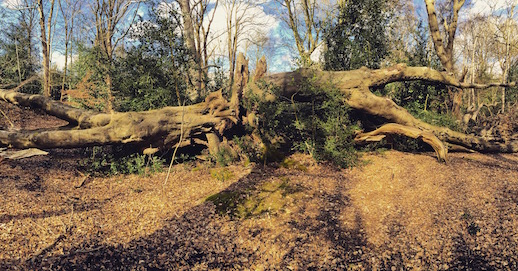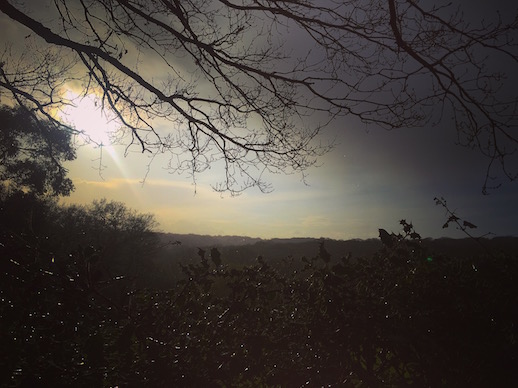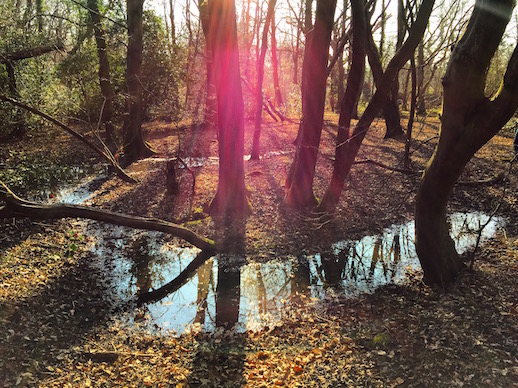In the first of a series of posts centred around Epping Forest – London’s biggest open space – Luke Turner inspects the damage left in Storm Katie’s wake & uproots an old family secret

Even in early spring, Epping Forest is defined as much by water as by wood. The trees, still largely dormant, are not yet sucking the rainfall out of the thick clay and gravel beds from which the forest rises on its ridge between the rivers Lea and Roding. The unsuspecting London walker, emerging from the warm and newly-rebranded and refurbished carriages of the London Overground at Chingford and the Central Line tube at Epping or Theydon Bois, had best be prepared. Walking boots are no good in this sort of weather, unless you’re lucky enough to be a Londoner with an outside tap – Epping Forest muck will not sit well with the dishes on your draining board. It is the mortal enemy of the white trainer.
I’ve been up there a lot recently, wellies sliding and sinking into that oomska with a gelatinous crackle under beech, silver birch and scrub oak just starting to prickle with green and brown buds. Paths sliced by off-road mountain bikers are viscous trenches requiring a spread-eagled walk, feet on the firmament on each side, hitherto unknown muscles screaming in protest at their workout from this handle-free cross-trainer.
Last weekend, after Storm Katie had kept me awake half the night doing her best to remove the attic roof I’m currently sleeping under, I took the train from St. James Street to see what she’d scratched from Epping Forest. One giant tree had cracked right down the middle and fallen in two directions, as clean and precise as a log split by a hatchet. As it toppled, it had pulled down branches from its neighbours, and shattered a couple of silver birches halfway up their trunks. I climbed onto the ruined tree to stand in its middle. Full of daft pomp and vanity, I imagined being born from it, the enclosing trunk falling away as if I were a human butterfly emerging from a cocoon. I jumped onto the stump, and immediately sank nearly to the top of my boots in stinking and wet rotten wood.
The River Ching and Loughton Brook were full and instant coffee brown. At one point a blocked culvert under the Green Ride had created a small lake in a forest valley behind it, tide mark visible on the beech leaf mulch, before it overran the path, scouring away some of the gravel and hardcore surface. Off piste, in the parts of Epping Forest where I always get lost, fallen trees dammed and diverted some of the tiny rivers, the craters left by upended roots already becoming minor ponds. Frogs were busy humping in drainage ditches, an amphibian plunge-pool orgy.
These walks have been both a counter and complement to days spent in libraries writing my way through the history of Epping Forest, its people, and my people. A lot of water drains from this ridge, the twelve by three mile stretch of woodland saved for the people of the London, its “natural aspect” preserved “forever” by the Corporation of London and the Epping Forest Act of 1878.

Above Drumaids, the gently sloping plain not far from where my dad grew up and went to school in Loughton, the weather ripped itself between winter and spring. To the West, the late afternoon sun burst through the trees, turning the sodden grey branches into candyfloss whirls of steely silver, crows streaking fire as they flapped towards me. In the East, retreating storm clouds gave way to a rainbow that peaked over the house where a blue plaque on the wall reveals that Royal mistress Mary Anne Clarke once lived. The colours curved to earth in a fallen log, dismembered by chainsaws and left to rot. Away to the North, just visible behind the billowing net curtains of rain, was the very tip of the spire of the church at High Beach, the middle point of the afternoon’s walk and not far from that great shattered trunk. Last autumn I found the location of its predecessor, St Peter’s High Beach by iPhone flicking between the blue dot of Google Maps and a photo of an old Victorian map, aligning roads and hedges, houses and trees.

In the dry orange light of October, a rectangular depression left by its four walls had been just about visible. Here, on August 27th 1854, my great-great-grandfather George William Turner was baptised, according to the faintly-inked entry in the church baptismal book that I found scanned in at the Essex records office in Colchester. His mother is recorded as Mary Ann but, appearing to confirm the Turner family legend of aristocratic philandering, no father is recorded alongside her. In this wet March of 2016, the ditches left by the robbing of their stone are full of turgid water, a strangely hard outline against the forest floor. A clump of young trees now rise from where the altar would have been at the eastern end of the church where I now stand and where, over a century before my lifetime, my obsession with Epping Forest was born.
Luke Turner is co-founder and editor of online music and arts magazine The Quietus. He has also contributed to Q, The Guardian, NME, MOJO and the BBC and is currently researching a book on Epping Forest.